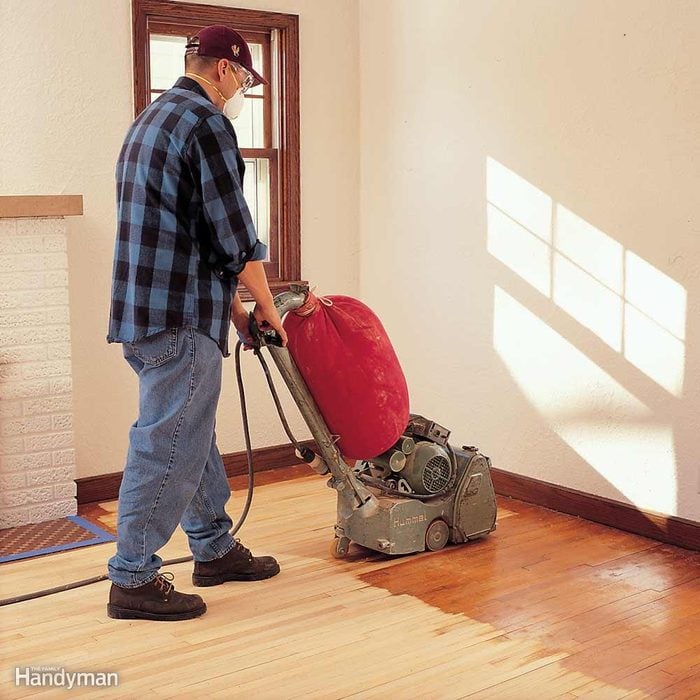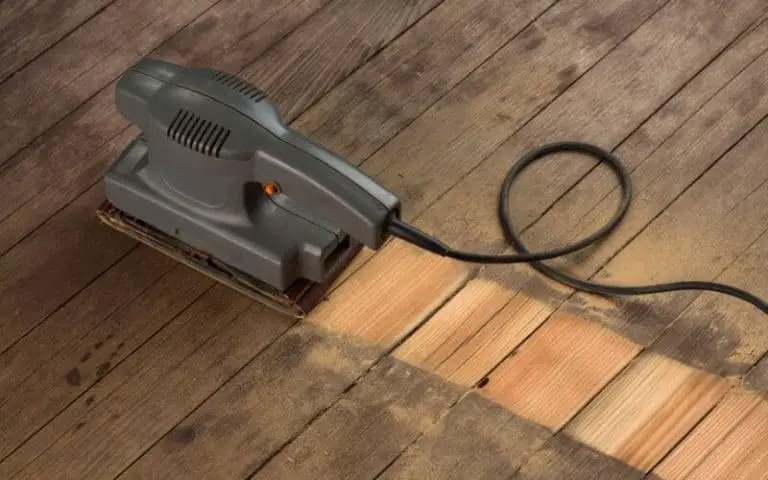Picture this: you’re standing in your living room, gazing down at the worn-out wood floor. You dream of restoring its former glory, breathing new life into the space. You’ve seen those sleek and powerful floor sanders at the hardware store, but what if you have a more modest project in mind? Can a humble hand sander, the kind you use for furniture, tackle the task of sanding a floor?

Image: www.familyhandyman.com
This is a question many DIY enthusiasts grapple with. Hand sanders, known for their portability and ease of use, seem like a tempting alternative to larger, heavier floor sanders. But before you dive into the project armed with nothing but enthusiasm and your trusty hand sander, let’s delve into the practicality, pros, and cons of using this tool for floor sanding.
Understanding the Limitations
Size and Scope
Hand sanders, by design, are built for smaller projects. Their footprint is compact, and their sanding surfaces are designed for detail work, not sweeping across vast expanses of wood. This makes them impractical for sanding large floor areas. If you’re dealing with a small section of floor, like a hallway or a single room, a hand sander might be acceptable, but for larger spaces, you’ll quickly encounter limitations.
Power and Efficiency
Hand sanders typically operate at lower power levels compared to floor sanders. While they can effectively smooth out minor imperfections and create a fine finish, they struggle with removing larger bumps, unevenness, or thick layers of old paint or varnish. This lack of power can translate into a significantly longer sanding time, turning your project into a tedious marathon.

Image: floorcarekits.com
When Hand Sanding *Might* Be An Option
Sanding Small Areas
If you’re tackling a small area, like a patch where a new floorboard has been inserted, a hand sander might be sufficient for blending the new wood into the existing floor. However, for a smooth, consistent finish, consider using a specialized “edger” sander, which is designed to work close to walls and corners.
Sanding Softwood Floors
Hand sanders might be more suitable for sanding softwood floors, such as pine or fir, which are less dense and require less power to remove material. However, even with softwoods, the sanding process will be more time-consuming.
Refining a Finish
Once you’ve used a floor sander or edger to remove most of the imperfections and prepare the floor, you can refine the finish with a hand sander. This final step helps create a smooth, even texture and eliminates any minor sanding marks left by the larger equipment.
Alternatives to Hand Sanding
Floor Sanders
For most floor sanding tasks, a dedicated floor sander is the most efficient and practical solution. These machines come in various sizes and configurations, catered to both large and small areas. Floor sanders are designed for high-speed sanding, making them ideal for stripping off old finishes, flattening uneven surfaces, and creating a smooth, uniform surface.
Edger Sanders
Edger sanders are smaller, specialized sanders designed for sanding close to walls, corners, and other hard-to-reach areas. They are a valuable addition to any floor sanding project, ensuring consistency and a seamless finish throughout your entire floor.
Drum Sanders
Drum sanders are a powerful choice for large-scale projects or for removing thick layers of material. They feature a large, drum-shaped sanding belt that can handle a heavy workload. While their power makes them ideal for large spaces, they require meticulous care and attention to prevent uneven sanding.
Safety Tips for Floor Sanding with a Hand Sander
While hand sanders seem less intimidating than their larger counterparts, safety remains paramount. Here are a few tips to ensure a safe and successful sanding experience:
- Wear a dust mask: Floor sanding generates fine dust that can be harmful to your respiratory system. Protect yourself by wearing a NIOSH-approved respirator mask.
- Use eye protection: Flying debris can cause serious eye injuries. Wear safety glasses or goggles whenever sanding.
- Avoid loose clothing: Keep your clothes tucked in and avoid loose accessories that can get caught in the sander.
- Work in a well-ventilated area: Open windows or use fans to ensure good air circulation and minimize dust buildup.
- Use caution with cords: If using a corded hand sander, ensure the cord is not a tripping hazard. Use proper cord management techniques.
- Disconnect the sander: When not in use, always unplug the sander and allow it to cool down completely.
- Inspect the sander: Before each use, inspect the sander for any signs of damage or wear. Replace worn-out parts or repair any issues before using the tool.
Can I Use A Hand Sander To Sand A Floor
Conclusion: Hand Sanding Floor Pros & Cons
In conclusion, while hand sanders can be useful tools for specific tasks, they are not the ideal choice for sanding an entire floor. Their limitations in power, size, and efficiency make larger, dedicated floor sanders a more sensible option for most projects. Remember, safety is crucial when working with power tools. Always prioritize your well-being by taking appropriate precautions and following safety guidelines. If you’re unsure about any aspect of floor sanding, consult with a professional for guidance.
Before launching into your flooring project, carefully consider your needs and the scope of your work. If you find yourself drawn to the practicality of a hand sander for small, intricate tasks, embrace it. But for larger, more demanding projects, the power and efficiency of a dedicated floor sander will ultimately reward your efforts with a flawlessly finished floor.





